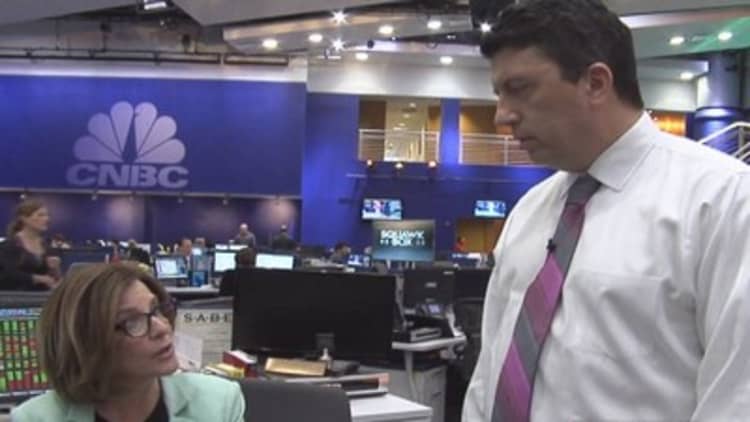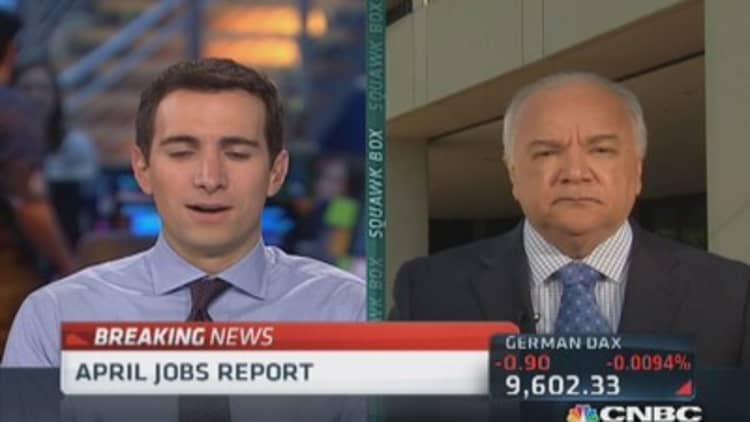
Job creation accelerated in April as the U.S. economy added 288,000 new positions, while the unemployment rate plummeted to 6.3 percent amid a sharp drop in the workforce.
Economists had been anticipating 210,000 new jobs and a 6.6 percent rate.
Despite the big number, not all the news was good: The headline rate tumbled as 806,000 people left the civilian labor force, a development one market strategist called "shocking." The labor force participation rate slumped to 62.8 percent, its worst of the year and near 35-year lows. Also, the average work week was unchanged at 34.5 hours, as were average hourly earnings at $24.31.
"The distortions that we've been getting out of the household data puts a cloud over the number," Gary Pzegeo, head of fixed income at Atlantic Trust, said in a phone interview. Though he described the report otherwise as "strong," he said the labor force drop "might set a worrying tone for the market."
Markets seesawed following the report and stocks turned lower in morning trade.
Read MoreIconic companies that disappeared
"Weather, sequestration, a significant buildup of inventory and other factors have helped bottle up some (economic) strength," Bart van Ark, chief economist at The Conference Board, said in a statement. "Now, it would appear, the absence of these factors is finally allowing the economy's underlying strength to come to the surface. The result is not just a relatively strong gain in jobs in April but probably more of the same in May and June and perhaps right through the summer."
Employment surged across sectors, with professional and business sectors adding 75,000 and retail gaining 35,000. Food and drinking establishments rose 33,000 while construction added 32,000 positions, according to the report from the Bureau of Labor Statistics.
The unemployment rates for various demographics plunged even more severely than the overall rate as workers in those groups exited the labor force.
The rate for 16- to 19-year-olds tumbled to 19.1 percent from 20.9 percent; the rate for blacks fell from 12.4 percent to 11.6 percent, and the Latino rate dropped from 7.9 percent to 7.3 percent. There labor force numbers corresponded. Some 13,175,000 Latinos were out of the labor force in April compared to March as the participation rate fell from 66 percent to 65.5 percent. The number for blacks moved to 12,080,000 from 11,956,000 as the participation rate declined to 60.7 percent from 61.1 percent. The labor force participation rate for teens fell from 34 percent top 33 percent.
"Over the prior 10-year period, the second quarter has always been the most robust for job growth; so it was critical we have a pop in April," said Todd Schoenberger, managing partner at LandColt Capital. "This figure bodes well for the rest of the quarter. Challenges may appear in the second half of the year due to slower GDP rates, but today's report is reason to celebrate."
Many market watchers had been anticipating a hot jobs number on belief that inclement winter weather had suppressed economic activity and cooled the jobs market, though the numbers didn't completely back that argument.
Read MoreJobs that didn't exist in
Revisions reported Friday further doused the weather story, as job creation was actually quite strong in the early months of 2014. Revisions pushed February's number to 222,000 and March's initially reported 192,000 to 203,000.
At the same time, the Federal Reserve has been forced to adjust its focus on the headline unemployment rate as a guide for policy.
The U.S. central bank had kept a 6.5 percent target as the trigger for a rate increase, but declining labor force participation and weak inflation ratings have forced the Fed to change its approach from targeting specific numbers to a more nebulous focus on the quality of economic conditions.
Friday's nonfarm payrolls report was unlikely to move the needle on Fed policy, which is focused on reducing the monthly bond purchases and keeping its target funds rate near zero.
Click here for market reaction




